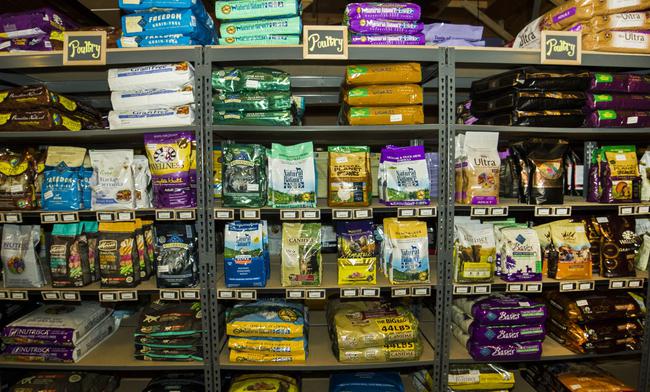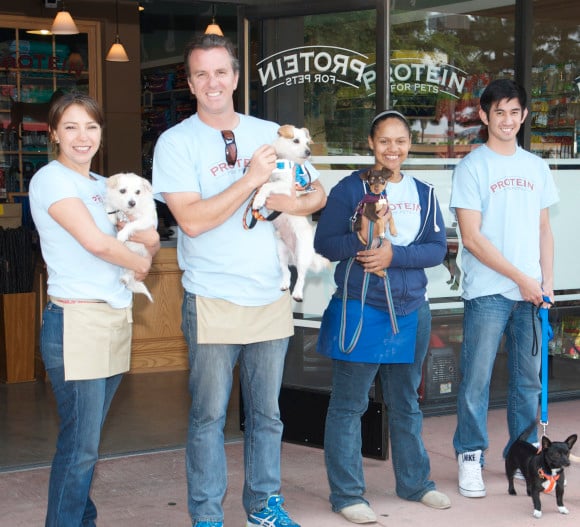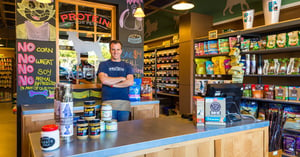Stroll the aisles of the nearest pet food store and, regardless of whether it’s an independent, neighborhood joint or a massive chain, you’ll notice the store invariably stocks all the food by brand, rather than by ingredient, type, or need.
It’s a strange method of stocking that clearly values manufacturers over consumers, a bit like if your grocery store stocked Coffee-Mate creamer, Buitoni pasta sauce, and Crunch bars next to each other simply because they’re all made by Nestle. Brand blocking highlights a brand’s wide product line while completely undercutting the consumer’s needs, making comparison shopping nearly impossible and ensuring the whole process of shopping for pet food is as time consuming and frustrating as possible.
Marco Giannini has set out to change all that. Instead of catering to the desires of pet food manufacturers, Protein for Pets stores are organized for consumers. The products are shelved according to need and ingredient, not by brand. The shelves themselves are organized like a wine store, with lower-priced items on the bottom shelves, and more premium brands at the top. Add to that retailer’s strict rules about which pet foods are allowed to take up shelf space at all. (Hint: The focus is on premium foods from trustworthy brands that shun the old industry staples like wheat, corn, soy, and animal byproducts.)

Premium pet food products, once reserved for wealthy pet owners, has grown to become the biggest seller in the pet food industry, demanding 42% of the category’s sales, compared to 30% going to traditional brands, 12% to value brands, and the rest to treats. The industry itself is also expanding: from ~$28 billion in sales in 2013, its expected to reach $33 billion by 2018.
So, it’s no big surprise that Protein for Pets, Giannini’s new chain of retail stores are doing so well despite the fact that it carries only premium brands — or maybe because of it.
The company has experienced breakneck growth—and has no plans to slow down. From opening its first door in Southern California, the company has grown to nine locations in just a year. “We plan to launch another eight stores in the next 12 months,” says Giannini. “We’ll move into Arizona and Nevada, then we’ll expand up and down the West Coast. Eventually we’ll move up to northern California, then to Oregon and Washington.”
It’s an ambitious plan.
We sat down with Giannini and talked about his approach to retail, the recent (and somewhat drastic) changes in the pet food industry, and how a company can scale into a national chain without losing that local, small-business feel.
So what made you want to move into retail?
We need a better way for consumers to shop for pet food. Stores are too big. They don’t shelve brand and merchandise products properly. It’s all merchandised by brand right now and it should be merchandised by needs. So, we’ve re-envisioned the modern pet store.
Why was the system like that in the first place?
It used to be that a pet store primarily sold pets, right? Birds, fish, reptiles and such. The dog food section was just a few brands on a shelf, next to the cat food and the birdseed. But the food part of pet stores has grown to be 85 to 90 percent food for dogs and cats. So they still follow the same format, organizing the store by brand versus by product or pet need. Pet stores don’t really sell aquariums and bird cages and animals anymore, yet, they still continue to follow the same format.
There’s been a flood of new pet food brands hit the market in the past few years. What’s been driving this?
In 2000, Iams decided to break their exclusive contracts with their distributors. When they did that, their distributors were left with massive amounts of space in their warehouses and they needed to keep the lights on. A lot of manufacturers popped up to fill the void, and that caused massive innovation within the industry. Suddenly there were tons of new products out there in the marketplace. It was a really exciting time. One decision by a billion dollar brand created space for smaller companies to innovate the market. The funny part is that Iams thought breaking their contracts would give them more control in the market, and instead it ended up creating their new competitors.
You’ve experienced remarkable growth. How did you expand to so many store so fast?
Our format is very simple. Each of our stores are 1,500 square feet in size. We have a tenth of the size of a Petco or a PetSmart and we have more natural food brands. But that’s actually better for the customer because we only carry the best brands and we organize the food better. When you walk into our store you know exactly where to go. If your dog is overweight, you go straight to the weight management section. If your cat is allergic to poultry, you don’t have to hunt through the store, because the stores are organized by need and ingredient. We’ve laid out the store so a consumer can walk in the store and find exactly what they need immediately.
What’s been the most surprising change you’ve seen so far?
Raw food. The growth of the raw food has been just unbelievable. I’ve been in the pet industry for 12 years. It’s been a challenge for us to figure out how to store enough of the raw food to meet the demand. We only had three door freezer space we had to reduce the amount of kibble we stored to accommodate for raw food. I thought all of these different types of kibble would be the biggest seller, but it turns out there are only a few types of kibble that people really want, the rest is the alternative foods and the raw foods.
This craze over raw pet food… What’s behind it?
Raw food has 85% of absorption rate. Kibble has no more than 45% of absorption. So you get twice as much absorption with raw food. The thing about raw food that people sometimes resist is the price. And this is what our private label is going to change. Because we’re already integrated, we’ve got reach, and we’ve got the store, have the ability to provide raw food at price point very close to kibble. That really hasn’t been done before.
Do you guys carry any kibble?
Of course. We carry lots of kibble. 65% of our store is kibble because that’s still the number one driver of pet food. But we make sure that none of the kibble in our store has any wheat, corn, soy, or animal byproducts.
What’s the plan for the private label?
We’re going to start with raw food, and then we’ll probably move into dry kibble. We’ll expand with treats, and then we’ll move into waste management. Until eventually 25 to 35 percent of the store will be private label.
What brought you to CircleUp for this funding round?
We went with CircleUp because it allows us to join a sort of Facebook for competitive investors, you know? It gives us the exposure necessary so we can continue to grow our company into a real retail juggernaut. I’m not going into a top secret industry here. I’m going into retail, where the more exposure you have, the better. The louder you are, the better. CircleUp, while it gave us a great group of accredited investors, it also gives us a great deal of exposure. We’re actually going up on CNBC Power Lunch, that’s directly because of CircleUp.

What are your primary uses of capital?
We plan to do three things: One, open up more stores; Two, marketing; and three, innovation through private label.
How are you planning to expand your marketing?
We want to get involved at the local level for each store. We plan give back a portion of our profits to public schools in the area of every store. We want to sponsor a dog walk every Saturday morning at every single store. It takes a great effort, obviously, to keep active at that local level as we grow. But it’s important to us to be very involved with community.
What are the biggest challenges around scaling and growth?
The biggest challenge when you have growth is to keep the local feel. You have stay very organized from a corporate level, but then keep pushing marketing strategies out on a local level. That’s easy with four stores. Ten stores, it gets trickier. Twenty stores it gets much trickier. We have a community dog walk each weekend. Imagine having a community dog walk in every single store on a Saturday morning when you have a hundred stores. It’s difficult, but you can do it. Starbucks did it for a long time, though now they’re starting to look cartoonish. Trader Joe’s has done it very well. Each store has a local flavor, murals of the beach in LA, street names for registers. It’s a chain, but it feels local. And that’s really hard to do.
What’s your best piece of advice for new entrepreneurs in the retail space?
You’ve got to start small, yes, but then you have to know how to scale. It’s tempting to make one store perfect, but that’s not scalable. Also, spend time on marketing, not money. What I mean by that is get your brand out into real events. We do a lot of event marketing. We reach out to schools and give them five percent back. We do the Saturday morning walks. We do a lot of little things that don’t break the bank.
In retail, there are no secrets. You can walk into any store and figure out what they do really well, right? So look around. How does Whole Foods differentiate themselves? How about Target? There’s no secret to it. But that doesn’t mean it’s easy. The skill is in the execution.
